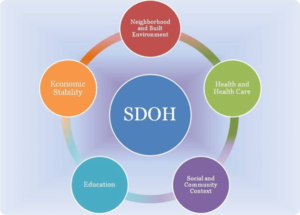This post is part of the Hogg Foundation’s “3 Things to Know” blog series, which explains concepts influencing community mental health and our grantmaking. Check out others in this series: Healthy Equity, Well-Being, and Resilience.
The World Health Organization (WHO) defines social determinants of health as “conditions in which people are born, grow, live, work and age.” In a previous post on the topic, Rick Ybarra, Program Officer for the Hogg Foundation, wrote:
“They include factors like socioeconomic status, education, the physical environment, employment, and social support networks, as well as access to healthcare. Typically, issues that go well beyond the scope of the traditional health care encounter between provider and client.”
The same can be said for the social determinants of mental health. In fact, health and mental health determinants tend to be interdependent. For example, you can’t expect a community’s health to improve if its mental health doesn’t, or vice versa.
Social determinants of health and mental health go hand-in-hand with health equity. The WHO says, “Risk factors for many common mental disorders are heavily associated with social inequalities, whereby the greater the inequality the higher the inequality in risk.”
Here are three things to know about social determinants of health and mental health:
1. Social determinants have complex impacts on health and mental health. People experience better outcomes when providers—and community leaders—use social determinant interventions.
Making sense of the connections between social determinants and individual mental health isn’t always easy. Factors like education, economic stability, social connection, neighborhood and community context, built infrastructure, and access to healthcare all impact a person’s well-being. So how do you know which determinants are at play, and what can you do to address them?
Luckily, a number of theoretical approaches have been developed for mental health providers who want to strengthen patient outcomes. Take a look, also, at the Centers for Disease Control and Prevention’s Tools for Putting Social Determinants of Health into Action. At the Hogg Foundation, social determinants of mental health have long been a driver of our grantmaking. Last year, we awarded $1 million in grants to two medical schools and a nonprofit organization to help them use a social determinants approach to advance their integrated healthcare programs.
But what if you’re not a mental health provider? We can all address social determinants. Take, for example, Hogg Foundation’s African American Faith-Based Education and Awareness initiative. It’s based on a mutual recognition—between grantmaker and grantee—that faith institutions are not just sites of spiritual development, but caregiving and community-building centers as well.
Doing away with the assumption that institutional spaces exist only to perform a single function opens us up to the idea that the places where people live, learn, work, play and pray can support a person’s well-being, especially with the help of collaborative interventions. One grantee, God’s Way Baptist Church in rural Taylor, Texas, is chipping away at social determinants rooted in geographic and race disparities.
2. Protective factors are as important to consider as risk factors.
The spectrum of social determinants of mental health isn’t limited to risk factors, which are more likely to lead to negative outcomes (e.g. poverty, community violence, substance use). Protective factors, which are more likely to lead to positive outcomes (e.g. supportive relationships, community safety, high self-esteem), are just as important to understand. Some factors are fixed (e.g. biological), while others can change over time (e.g. income level).
To be effective, prevention tactics must tackle both sides of the coin and address risk and protective factors in multiple contexts, including relationships, communities, and society at large. When carrying out interventions through an after-school program, a linguistically competent tutoring program, or culturally competent mental health support, it’s important to bring an understanding of the contexts in which a child operates. What are the conditions at home, in his/her neighborhood, and in the broader community, and how can the activities of the intervention influence one or more social determinant in his/her life (e.g. peer network, education level, access to quality healthcare)?
At God’s Way Christian Baptist Church, youth-oriented activities are as focused on facilitating conversations about community struggles as encouraging a healthy development of self-esteem. This is because their wellness ministry leaders see both as critical to learning about the repercussions of mental health stigma and building a better health future for its congregants.
3. The impact of a social determinant might not be immediate, but reveal itself over time or in crisis.
Just because the impact of a given social determinant isn’t immediately felt or measurable doesn’t mean it’s not significant. The factors that contribute to prevalence of a chronic disease can take decades or generations to surface—a time lag that’s difficult to study, but critical to our ability to address them over time. The evidence of social determinants becomes obvious once we’re equipped to recognize it, and crisis makes it all the more visible.
In an Into the Fold podcast episode on community resilience, Lourdes Rodriguez, director of the Center for Place-Based Initiatives at The University of Texas at Austin’s Dell Medical School, said disasters like Hurricane Harvey bring a “magnifying glass” to a community’s “tender points,” or the social determinants that make some more vulnerable than others. Harvey’s impact on mental health, like that of Hurricane Katrina, will continue to play out for years to come, particularly for residents with low income.
Class, gender and race—which, in turn, affect factors like social norms, residential segregation, and language barriers—also function as social determinants of mental health, and it’s true that moments of crisis cast a harsh light on existing systems of inequality. In their aftermath, however, there exists a real opportunity to create solidarity and resilience—and, through preventive strategies and services, enrich community life and thus, the health and mental health of community members.
Resources
- Healthy People 2020’s Social Determinants of Health: A comprehensive overview of social determinants, interventions and resources.

